Authentic German Sauerbraten
This post may contain affiliate links. See my disclosure policy.
One of Germany’s national dishes, this authentic German Sauerbraten features beef roast that is marinated, cooked until fork tender, and served with a wonderfully rich and flavorful sweet-tangy gravy! Serve it with the traditional sides of Rotkohl, potatoes, Semmelknödel, Kartoffelklöße, or Spätzle for a hearty and thoroughly satisfying and unforgettable meal. And whether you’re serving it for a special occasion, casual family gathering, or as part of your Oktoberfest dinner, you’re all set for a memorable feast!
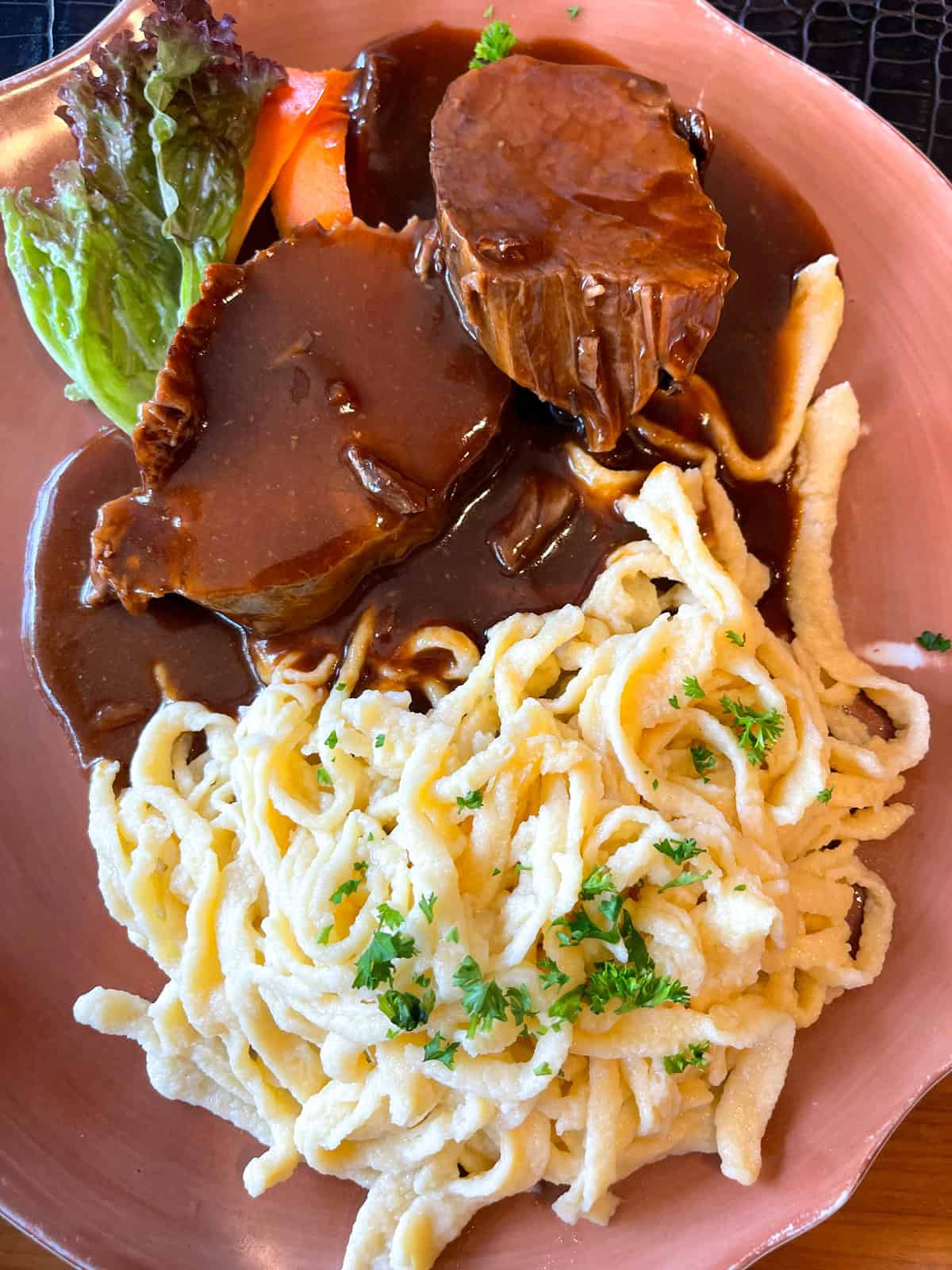
Growing up in southern Germany until moving to the U.S. in my mid-20’s, Sauerbraten was a dish I frequently enjoyed and always looked forward to. Both my Mutti and my Oma would make it served with Rotkohl and either Semmelknödel or Kartoffelklöße, sometimes Spätzle, and it was a memorable feast every time. It was also a dish we enjoyed ordering at restaurants, with each region of Germany adding their own touches and variations.
What is Sauerbraten?
Sauerbraten is a traditional German beef roast that is marinated, browned, and slow-cooked. It is marinated in a mixture of vinegar, wine, spices and herbs over the course of several days which tenderizes the meat and infuses it with its characteristic tangy flavor (hence the name sauerbraten, the German word for “sour roast”).
Sauerbraten is a dish that definitely requires some advance planning as the roast has to marinate for about a week before it’s ready to cook. Don’t cut corners by shortening the marinating time and or holding back on the marinade ingredients. Prepare that amazing marinade, let the meat marinate fully and then reap the rewards for your patience!
Where Did it Originate?
The origin of Sauerbraten has been ascribed to Julius Caesar who is documented as having sent beef marinated in wine all the way from Rome to the new Roman colony of Cologne. Saint Albert the Great of Cologne was later credited with having popularized the recipe in the 13th century. Originally the dish was most commonly made with horse and there are a few restaurants that still serve it, but today it’s primarily made with beef. Less commonly it’s also made with venison or lamb.
This quintessential German dish is found on the menus of many German restaurants both in and outside of Germany. It has been one of Germany’s most popular dishes for generations and as such has become one of its official national dishes.
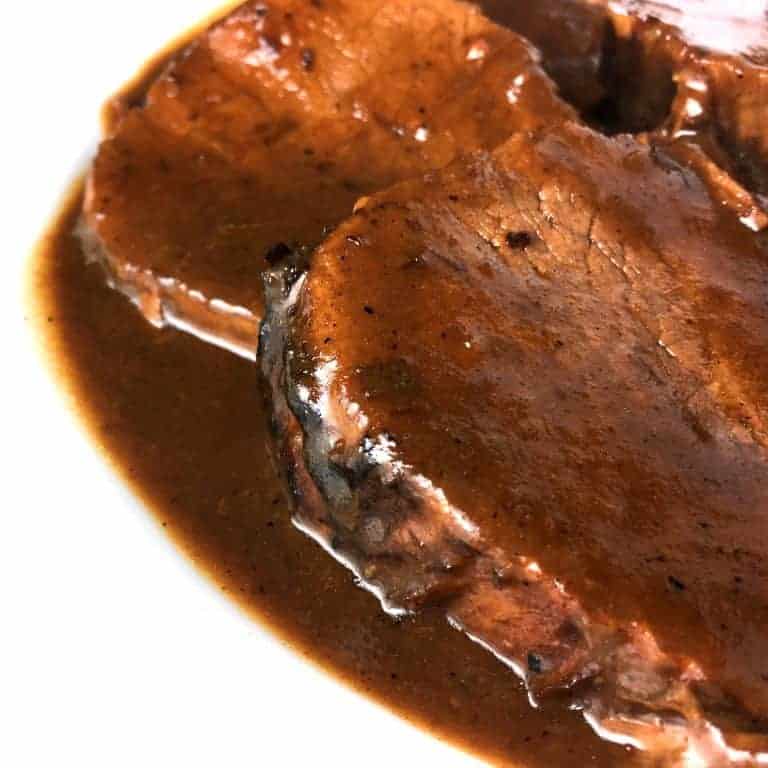
Sauerbraten Ingredients
Sauerbraten recipes vary by region, each adding their own touches. In addition to the sour component there is always the addition of sweet ingredients to balance the acidity and sourness of the sauce. Some regions do this by adding Lebkuchen or ginger snap cookies, raisins, sugar, honey or sugar beet syrup (or often a combination of them) to achieve that balance. To make this traditional Sauerbraten recipe you will need:
- Vegetables: Yellow onions, carrots, leek and garlic go into the marinade and will later be cooked along with the sauce. The leek contributes a fabulous authentic German flavor to the dish so however you may be tempted to omit it, I strongly recommend including it.
- Herbs and Spices: Thyme, rosemary, bay leaves, juniper berries, cloves, peppercorns, salt and sugar all contribute to that authentic Sauerbraten flavor. Juniper berries are very traditional in German cooking, particularly with beef dishes. They contribute a unique woodsy, piney flavor that can’t be replicated any other way. You can buy them online. While I do recommend using them, you can omit them if you can’t find them.
- Red Wine: This forms the bulk of the marinade along with the red wine vinegar. You don’t need an expensive wine because any subtle flavors will be lost in all the seasonings. Choose an inexpensive table wine (but avoid “cooking” wines). Good choices include cabernet sauvignon, merlot or pinot noir.
- Red Wine Vinegar: This creates the “sour” component in Sauerbraten.
- Beef Roast: Tougher cuts like bottom round or rump roast are traditional but you can also use chuck roast for a fall-apart pot roast version.
- Bacon: This is optional and while some variations include it, many do not. I like to include it because that savory-smoky flavor element is fabulous in the final dish.
- Raisins: The inclusion of raisins varies by the region of Germany. Where I’m from in Southern Germany raisins are not included but I occasionally add them because they contribute a really nice flavor and sweetness.
- Ginger Snap Cookies: In Germany things like Lebkuchen or Honigkuchen are traditionally added. Ginger snaps make a great substitute. This adds flavor complexity and sweetness to the dish and also serves as a thickener.
- Honey: This adds sweetness to balance the acidity of the vinegar. Some regions of Germany traditionally use sugar beet syrup instead.
- Flour: To thicken the gravy.
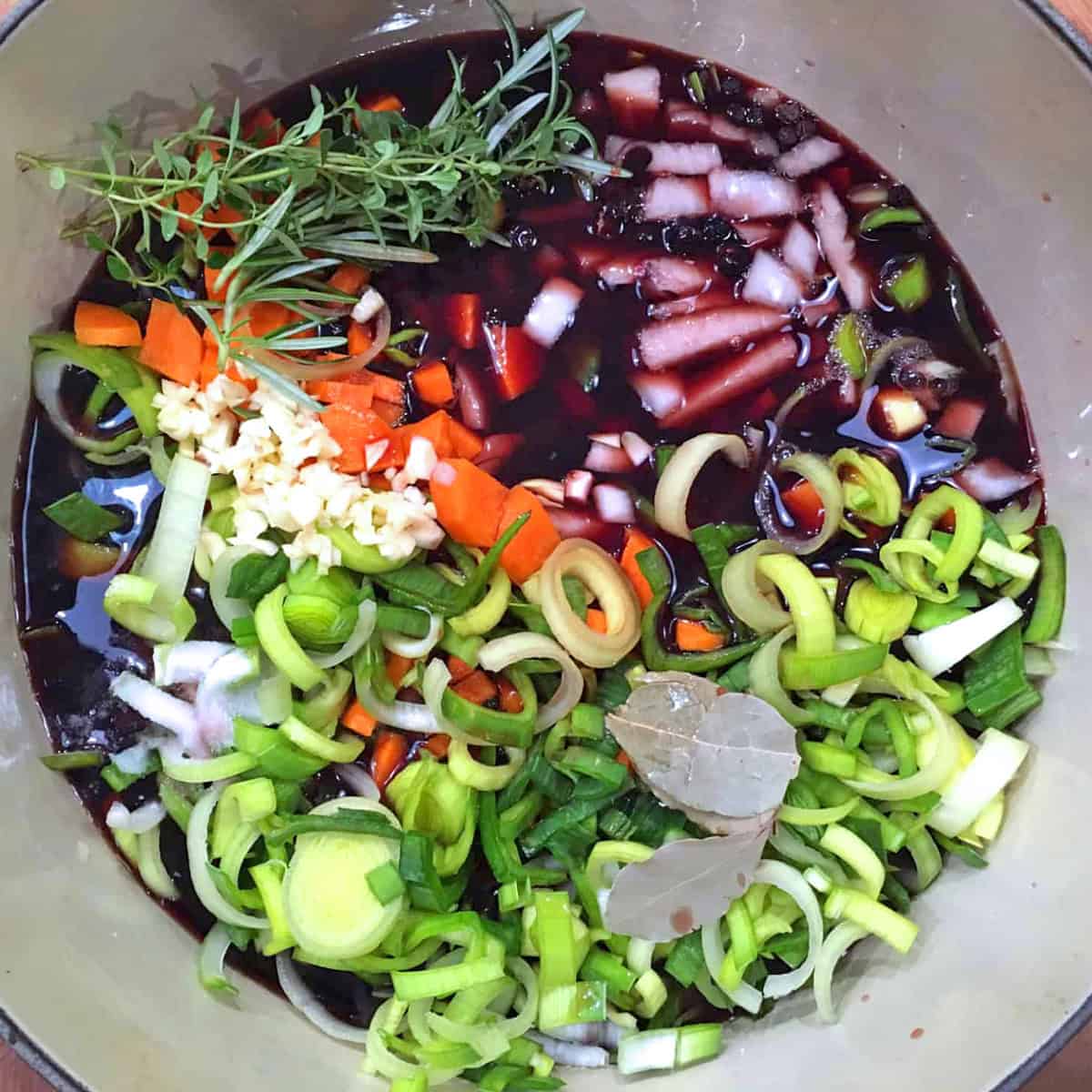
Sauerbraten Recipe
Let’s get started!
Place all of the veggies and herbs in a heavy stock pot or Dutch oven along with the garlic, juniper berries, whole cloves, bay leaves, salt, sugar and peppercorns. Add the red wine, red wine vinegar and water.
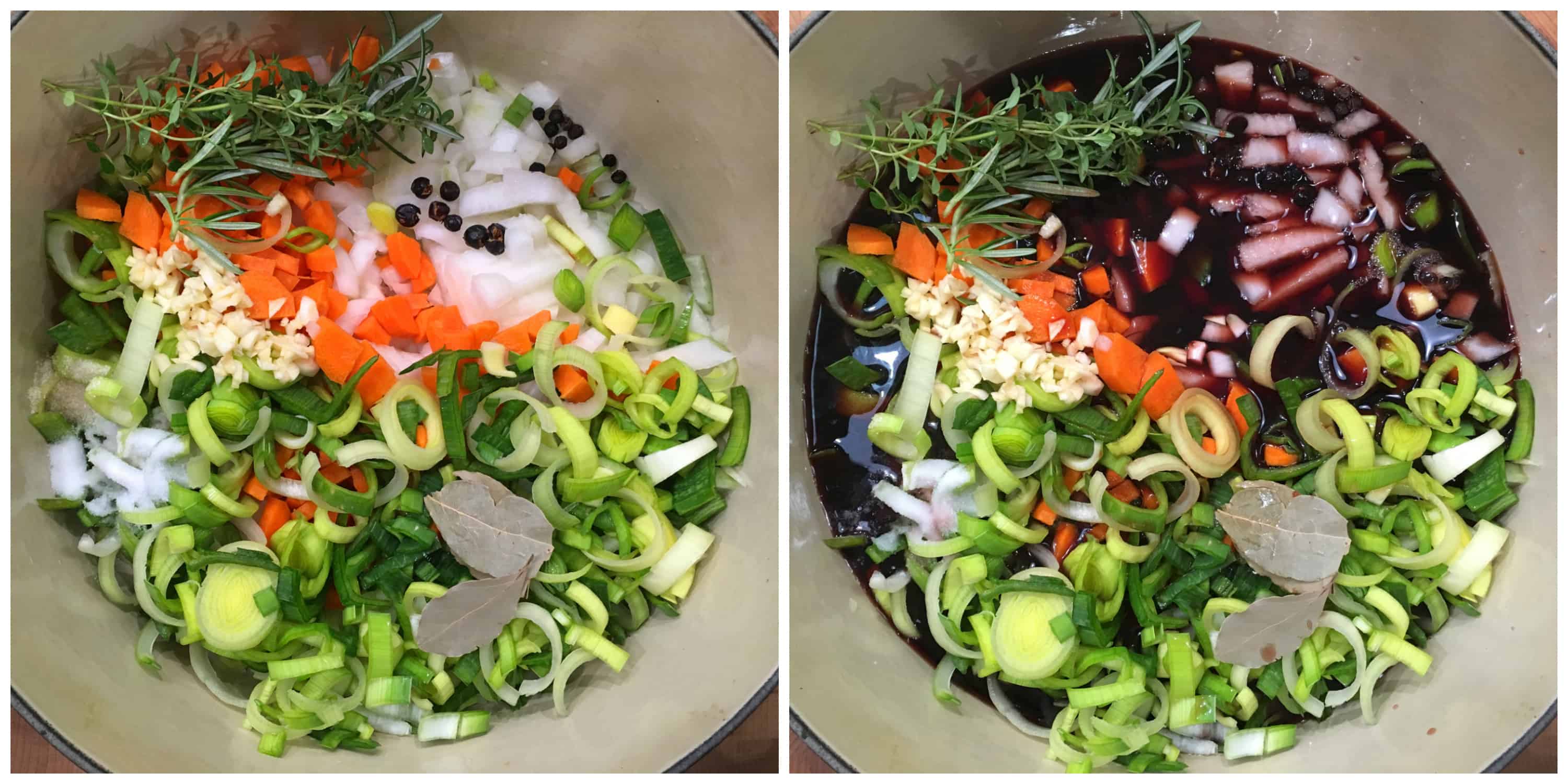
Bring the mixture to a boil, reduce the heat, cover and simmer for 10 minutes. Turn off the heat and let the mixture cool down completely. Nestle the roast in the vegetable marinade and place the lid on the pot.
Let it marinate in the fridge for at least 4 days, preferably 7. (Traditionally, the marinating time is as long as 2 weeks!) Unless the meat is completely submerged under the liquid, turn the roast over once every day.
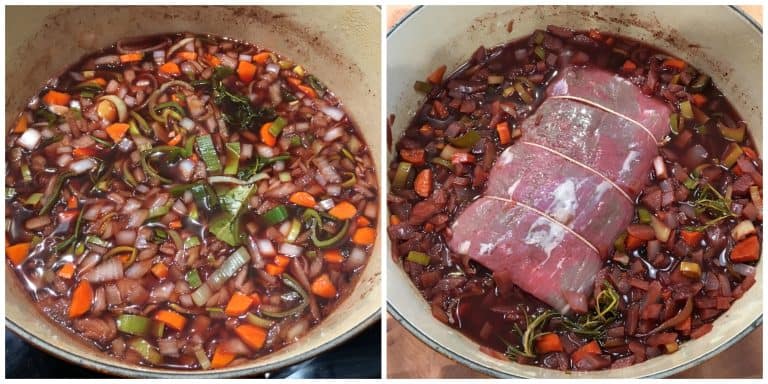
Remove the roast and strain the liquid from the vegetables. Reserve the liquid and the vegetables.
Pat the roast dry with paper towels.
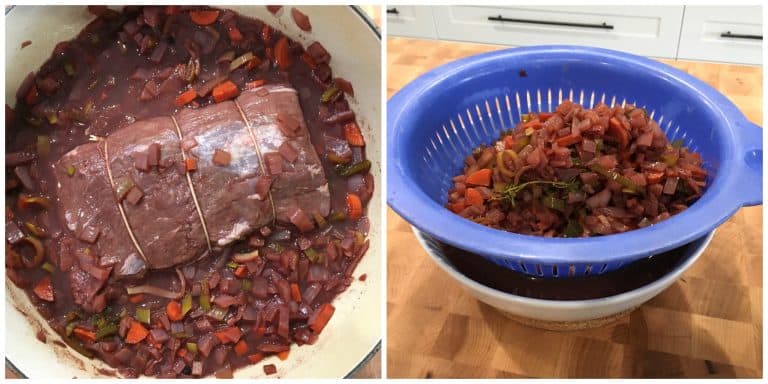
Rinse the pot out and heat a tablespoon or two of oil in it over high heat. Generously brown the roast on all sides.
Remove the roast and set aside. If using bacon, fry the bacon until done.
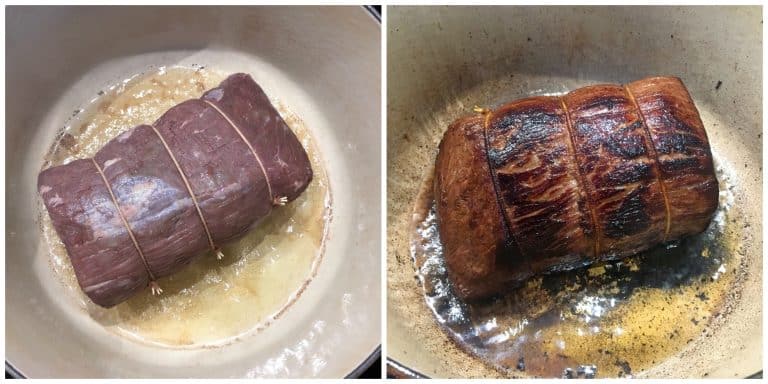
Leave about 2 tablespoons of the oil/fat in the pot. Place the strained vegetables in the pot (along with the bacon if using) and cook for 5-7 minutes. Stir in the flour, cooking the mixture for a minute or two to eliminate the flour flavor. Add the liquid that you strained from the vegetable marinade, bring it to a boil, stirring constantly to prevent lumps.
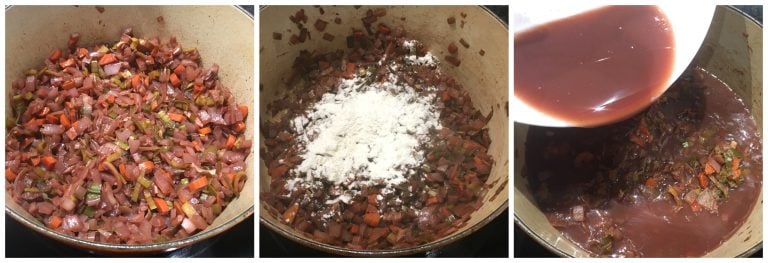
Add the raisins, honey and crushed ginger snaps. Return the roast to the pot.
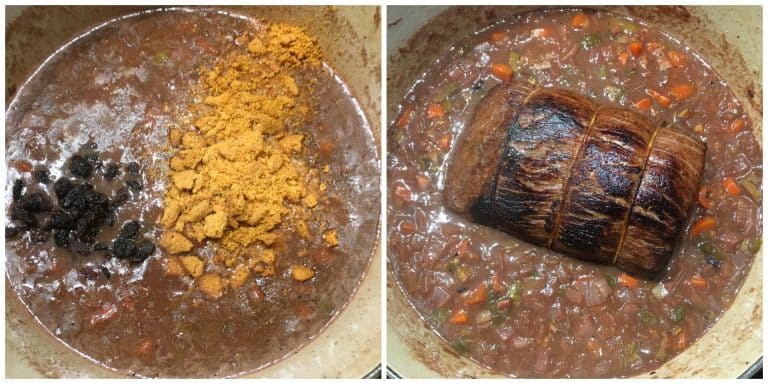
Bring to a boil, reduce the heat to low, cover and simmer for 2-4 hours or until the meat is very tender. Cooking time will vary depending on the type of roast and how long the roast marinated. It takes a while for the tough connective tissues in the meat to get up to temperature to start breaking down, so if the beef isn’t tender continue cooking it.
Note: The longer you let the roast marinate the faster it will cook because the meat will be more tender from the start. So check on your roast periodically for doneness.
When the roast is done, remove and transfer it to a plate and let it rest for 5 minutes before slicing. In the meantime, strain the gravy.
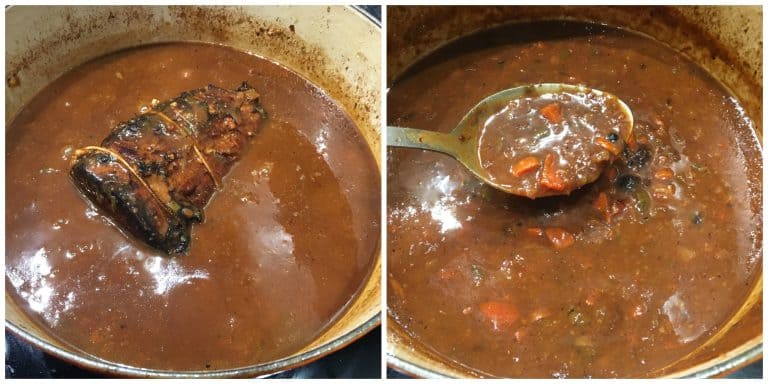
Strain the gravy and return it to the pot. Taste and more sugar, salt and pepper as desired. If you want your gravy thicker, make a cornstarch slurry to thicken the gravy.
Note: The balance of sour to sweet is a matter of personal taste – adjust the flavor according to your preference. If the flavor is too strong for you, you can also dilute it with a little water or broth.
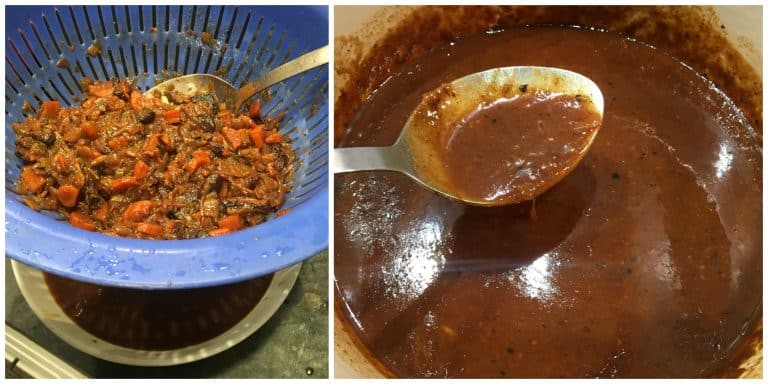
Let the roast rest for 5 minutes after removing it from the pot. Then slice the roast.
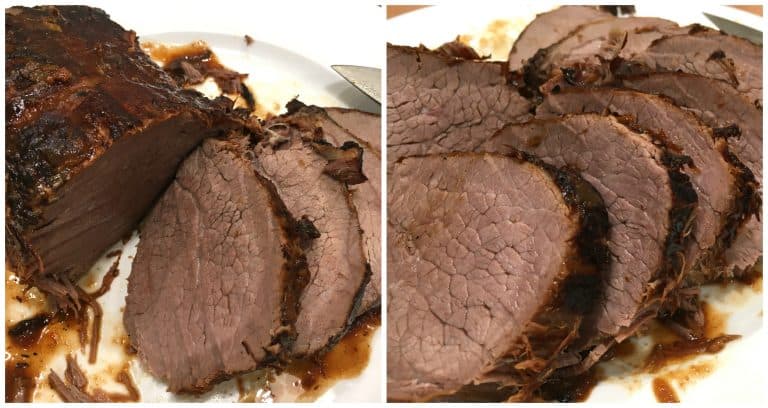
Spoon the hot gravy over the sliced Sauerbraten and serve immediately.
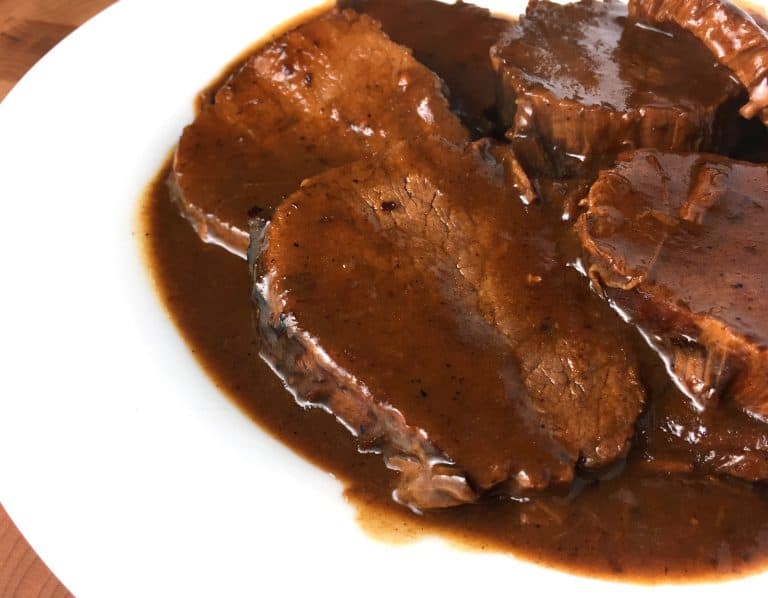
What to Serve with Sauerbraten
There are several traditional sides you can serve with Sauerbraten. These include:
- Kartoffelklöße – these are German potato dumplings and they are popular throughout every region of Germany. They’re made from potatoes and are pillowy soft, making them perfect for mopping up that luscious gravy.
- Semmelknödel – another traditional dumpling, these are bread dumplings seasoned with herbs. These are especially popular in southern Germany where they originated but are served throughout the country.
- Spätzle – the famous noodles from the Swabia region of southern Germany (where I’m from), and when you’re in Baden-Württemberg and order Sauerbraten this is the most popular accompaniment.
- Kartoffelpuffer – where I’m from in Swabia these German potato pancakes are served with sweet accompaniments but in other regions, such as Rhineland-Palatinate, they’re also served as accompaniments to savory dishes, like sauce-based meat dishes. In the case of Sauerbraten, I would serve them in addition to one of the dumpling options or Spätzle.
- Boiled or mashed potatoes – not as exciting as the options above but still perfectly acceptable :)
- Rotkohl – this braised German red cabbage is a must. It is the quintessential traditional side for roast beef in Germany.
- German Potato Salad – definitely the Swabian or Bavarian oil-and-vinegar potato salad varieties, not the mayo-based kind.
- Creamy German Cucumber Salad or the vinegar-based German Cucumber Salad (Gurkensalat) – either of these make a really nice and refreshing accompaniment.
- German Tomato Salad (Tomatensalat) – another refreshing option.
- Bohnensalat – a refreshing green bean salad.
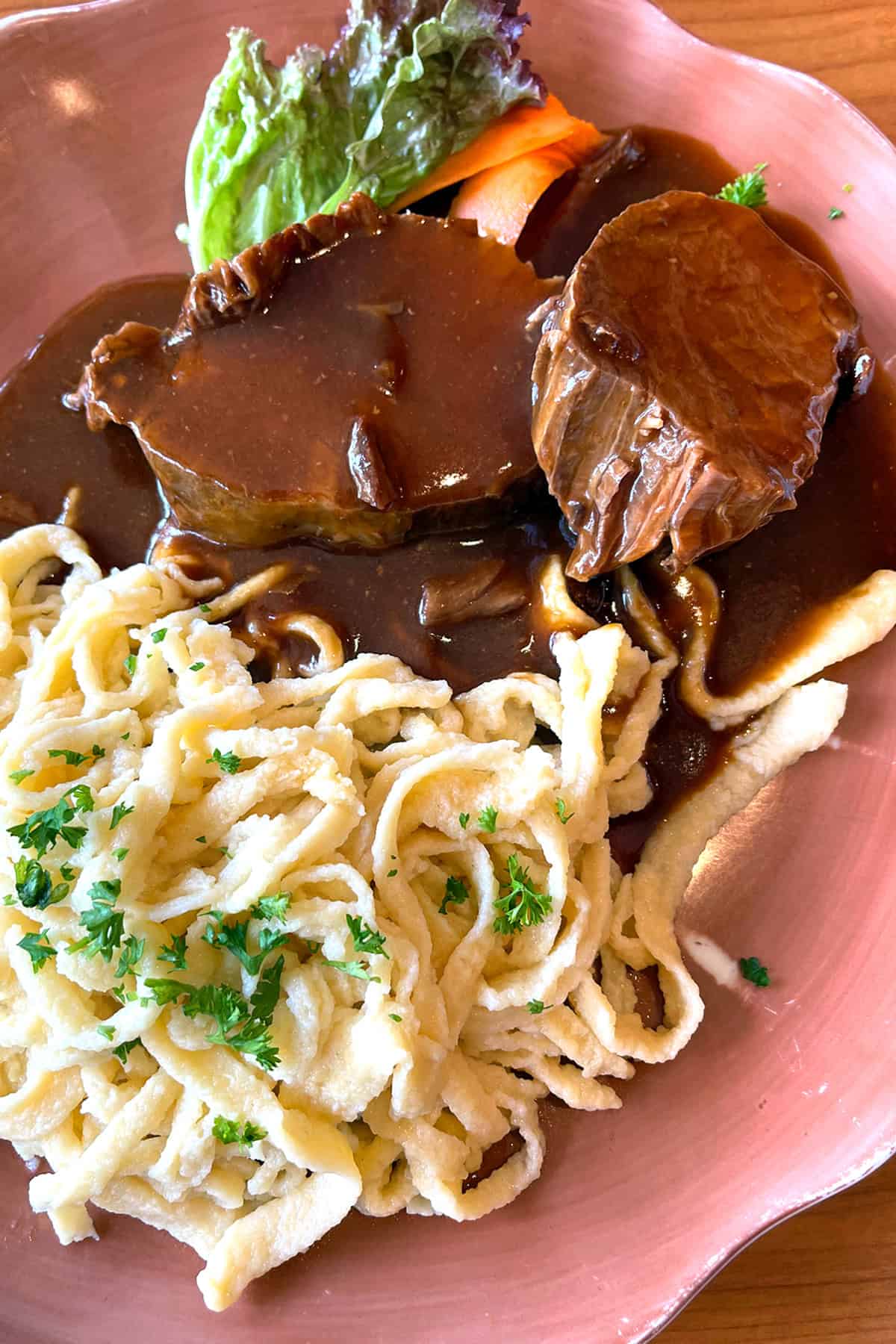
Storage and Reheating
Sauebraten can be made in advance and reheated. I like to pre-slice the meat and store it in some of its gravy to preserve moisture, and then reheat it along with the remaining gravy to serve at the table. It will keep in the fridge for 3-4 days and can be gently reheated in the microwave in a covered container, on the stovetop, in a crockpot, or in the oven.
Sauerbraten can also be frozen. Pre-slice the roast, let it fully cool, and freeze it with the gravy in a freezer-safe container for up to 3 months. Let it thaw slowly in the refrigerator and then gently reheat.
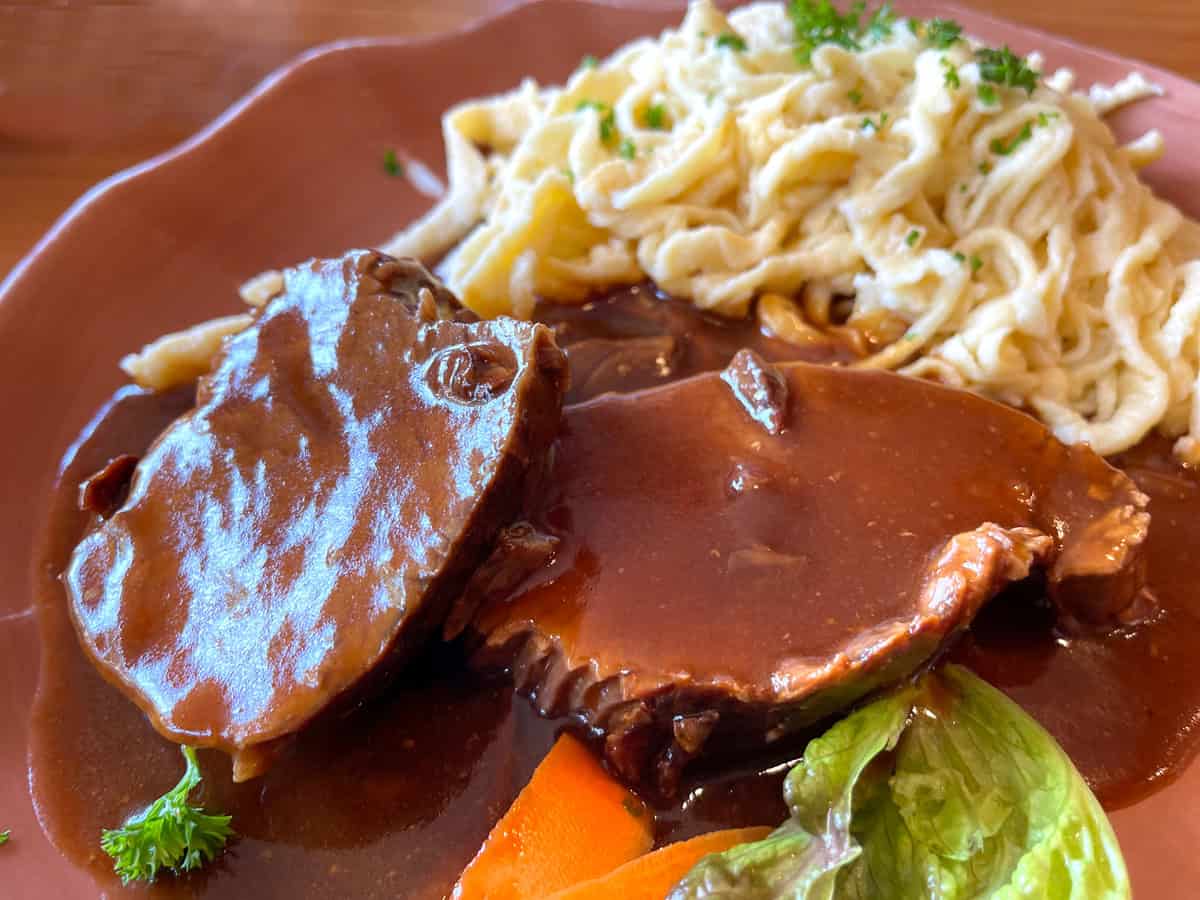
For more delicious German recipes be sure to try my:
- Schnitzel
- Jägerschnitzel
- Königsberger Klopse
- Senfbraten
- Schweinshaxe
- Maultaschen
- German Potato Soup
- Frikadellen
- Currywurst
- Käsespätzle
- German Sauerkraut Soup
- German Bread (Vollkornbrot)
Save This Recipe
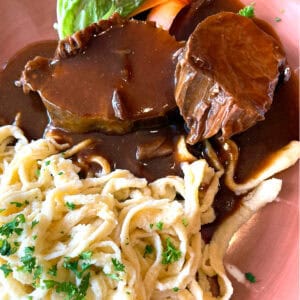
Authentic German Sauerbraten
Equipment
Ingredients
- 2 large yellow onions , chopped
- 2 large carrots , diced
- 1 large leek , chopped, thoroughly washed and drained to remove any dirt
- 3 cloves garlic , minced
- 2 large sprigs thyme , or 1 teaspoon dried
- 2 small sprigs rosemary , or 1 teaspoon dried
- 2 bay leaves
- 8 juniper berries , cracked
- 6 whole cloves
- 10 whole black peppercorns , cracked
- 2 1/2 teaspoons salt
- 1 teaspoon sugar
- 2 1/2 cups dry red wine (e.g., cabernet sauvignon, merlot, pinot noir)
- 1 cup red wine vinegar
- 1 1/2 cups water
- 4 pounds beef roast (tougher cuts like bottom round or rump roast are traditional but you can also use chuck roast)
- 4 slices bacon , finely diced (optional); some variations include but most do not
- 4 tablespoons all-purpose flour
- 1/4 cup raisins
- 3 ounces ginger snap cookies , crumbled
- 1 tablespoon honey
Instructions
- Prepare the Marinade: Place all of the veggies and herbs in a heavy non-reactive stock pot or enameled Dutch oven along with the garlic, juniper berries, whole cloves, bay leaves, salt, sugar and peppercorns. Add the red wine, red wine vinegar and water.Bring the mixture to a boil, reduce the heat, cover and simmer for 10 minutes. Turn off the heat and let the mixture cool down completely.
- Marinate the Meat: Nestle the roast in the vegetable marinade and place the lid on the pot.Let it marinate in the fridge for at least 4 days, preferably 7. (Traditionally, the marinating time is as long as 2 weeks!) Unless the meat is completely submerged under the liquid, turn the roast over once every day.Remove the roast, pat it dry with paper towels, and strain the liquid from the vegetables. Reserve the liquid and the vegetables.
- Cook the Roast: Rinse the pot out and heat a tablespoon or two of oil in it over high heat. Generously brown the roast on all sides. Remove the roast and set aside. If using bacon, cook the bacon until done. Leave about 2 tablespoons of oil/fat in the pot. Place the strained vegetables in the pot (with the bacon if using) and cook for 5-7 minutes. Stir in the flour, cooking the mixture for a minute or two to eliminate the flour flavor. Add the liquid that you strained from the vegetable marinade, bring it to a boil, stirring constantly to prevent lumps.Add the raisins, honey and crushed ginger snaps. Return the roast to the pot.Bring to a boil, reduce the heat to low, cover and simmer for 2-4 hours or until the meat is very tender. Cooking time will vary depending on the type of roast and how long the roast marinated. (Note: The longer you let the roast marinate the faster it will cook because the meat will be more tender from the start. So check on your roast periodically for doneness.)When the roast is done, remove and transfer it to a plate, tent it to keep warm, and let it rest for 5 minutes before slicing.
- Prepare the Gravy: While the roast is resting, strain the gravy and return the gravy to the pot. Taste and more sugar, salt and pepper as desired. If you want your gravy thicker, make a cornstarch slurry to thicken the gravy. (Note: The balance of sour to sweet is a matter of personal taste – adjust the flavor according to your preference. If the flavor is too strong for you, you can dilute it with a little water or broth.)Spoon the gravy over the sliced Sauerbraten and serve immediately.
- Serve with Rotkohl and boiled potatoes, Spätzle, Semmelknödel or Kartoffelklöße . A few parts of Germany even serve it with Kartoffelpuffer.
Nutrition
Originally published October 2, 2018



















I was wondering if you have an internal temperature to cook sauerbraten to , to be tender enough.
For brisket , it’s 204 degrees
Hi Jerry, it’s very similar for a bottom round or eye roast. It’s an extremely lean cut and so it requires an especially long cooking time in order to break down the connective tissues. Aim for an internal temp around 200 F.
I tried this recipe a few weeks ago and was thrilled. I had always tried to get my mother’s recipe for Sauerbraten but she did everything by taste and a little bit of this and a handful of that. I could never get the flavors right. This recipe was easy and absolutely delicious. I made it with the red cabbage and the potato pancakes, also a favorite of mine. Smelling the meat cooking for a good part of the day, I was absolutely starving by the time I ate and it did not disappoint. My next adventure will be the maultaschen. Thank you so much for posting such great recipes!!
I am beyond delighted that you took the time to make the Sauerbraten along with the red cabbage and potato pancakes and that everything was such a success, hooray! Thank you so much for the feedback and I hope you’re equally happy with the Maultaschen!
Excellent recipe. Just 1 comment – I think it would be best to cut the meat into thick slices and marinade then. Rather than marinading a whole chunk of meat. This way you get more of the lovely flavour inside the meat.
Thank you, Jan, I’m so glad you enjoyed it! You can definitely do that if you prefer, you’d just want to cut the marinating time way down as well as the cooking time to prevent the meat from drying out.
I followed recipe exactly. Two weeks in the fridge. I was honestly disappointed. Don’t know what I expected. It was good. I personally enjoy a plain roast much more than all this fuss. I’ve never tasted German. Not impressed. Thank you for the recipe and chance to try something different.
Thanks a lot for the recipe.
Can I cook the Sauerbraten in a German ” Roemertopf”, slow cooking in the oven? The Roemertopf is enameled inside. What do I need to pay attention to?
Could I use malt vinegar instead of red wine vinegar?
Thanks in advance for you reply.
Hi Heidi, malt vinegar is made from ale instead of wine and so will of course have a different flavor but yes, you can use it if you don’t have red wine vinegar. Yes, you can cook it in the Römertopf but will need to be careful to follow the user instructions for soaking the clay pot before using it (so it doesn’t crack) and adjusting the cooking time.
This recipe was amazing! I used a 2lb chuck roast and kept the spices the same not realizing that the recipe was for a 4lb piece of meat. Still turned out fine, not over salted. I marinated for 7 days in a covered large glass bowl and turned over every few days. I cooked for 2 hours, meat was still extremely tough. Then for 4 hours and it was still tough. I began to lose hope and figured I had just done the recipe wrong. So I cooked on low in a pot for about 6 more hours and viola! Tender, fall apart meat. Sometimes it just takes more time for the meat to become tender. Amazing recipe will definitely make again.
Wonderful, I’m so glad you enjoyed it, Maddie, and I really appreciate the feedback, thank you!
Hi Kim, one more question. Have you ever cooked the roast ahead of time and reheated it in gravy? I’m cooking for 10 people sat. and would like to cook on Fri. slice and reheat in oven Sat. Any idea if this would work and for how long to reheat? I have 8lb I’m cooking. I’m also making the dumplings to go with it from your recipe. Have you ever made the dumplings the day before and waited to boil them the day of the party? Or if boiled can they be reheated in the oven rather than the microwave? Would take a long time to reheat for 10 people. I need a way to do most beforehand as the day of will not have a lot of time day of. Im hoping you see this today as I want to cook tomorrow. ANY HELP APPRECIATED
Hi Dorothy, yes, the roast can be made in advance and slowly reheated in the gravy either on the stovetop or in the microwave. As for the dumplings, I haven’t tried forming them into balls, storing them in the fridge, and then boiling them the next day, but I don’t see why that wouldn’t work. Again, I can’t speak from experience though and if you give it a try let us know how it goes. As for reheating them in the oven in the absence of a microwave, yes you can do that, you’ll just want to take steps to avoid them getting dried out, such as putting them in a covered casserole dish to reheat so that the moisture doesn’t all evaporate.
Very good very authentic! I’m german! One thing I do instead of simmering on stove is put in a crock pot on low until tender! I personally love Chuck roast (more fat) however husband likes the leaner cuts! Spatzel is the best with this! If you have never had saurbraten I think your either gonna love it or hate it! If you like vinegar and clove you should love it! Don’t forget nutmeg in your Spatzel
don’t expect this to taste like an American pot roast!
Thanks so much for the feedback, Missy! :)
I’m making this and I have a 8lb roast. Do you have any idea how long 8lb would take or how Many min a lb about to cook I’ve always cook roast in oven but this is boiled so don’t know how long to cook is there an internal tem. I’m going to double rest of ing so I get a lot of gravy looking forward to this
Hi Dorothy, the cooking time varies so much depending on both the type of roast used and especially how long the roast is marinated. The cooking time can range anywhere from 2-4 hours and you’ll need to check on it periodically, probing it with a fork, to determine when it’s nice and tender. Happy cooking! :)
Hello, just made marinade and it smells amazing. I have chuck roast. How should I adjust the roasting time? I usually roast low and slow for this cut but unsure due to the marinade. Thanks so much!
Hi Jennifer, the cooking time varies greatly depending on the type of roast and how long you marinate the roast. You’ll need to check it periodically, probing it with a fork, to determine when it’s nice and tender. Happy cooking and please let us know how it goes!
Just a follow up. I marinated the roast for 2 weeks in a freezer storage bag. Cooked it as directed and the meal was simply amazing!!! So tender and flavorful, I am sure to make this again!! Thank you.
Wonderful! I’m thrilled it was a success, Michelle, thank you so much for taking the time to return and report!
If you marinate beef for 7 days do you have to worry about beef going bad. I want to try 5is but should I merinare in freezer or is frig safe. Someone said they merenated for 2 weeks
Hi Dorothy, it’s perfectly safe in the fridge. The high vinegar content acts as a form of preservative; think of it as “pickling” the beef.
Thank you for you for the authentic recipe. I used a rump roast for this marinated for 6 days, followed the recipe exactly but the meat was sort of gray and tough. The sauce was great but the meat wasn’t great. It was edible. I did something wrong, clearly. Any ideas?
Sounds like you might not have braised the meat long enough. On a long cook like this the meat will actually toughen up and force out some moisture becoming dryer until the connective tissues start to break down and turn to gelatin. When that happens the meat softens and becomes more moist but that doesn’t even begin to happen until the meat reaches over about 190 degrees Internal temperature. Did you happen to check your roast’s temperature when you removed it from the oven?
I have always used beef Brisket which falls apart with a fork after long slow cooking. My Mother was German and used this meat all the time. Rump needs at least 7 hours at 170 degrees to soften up… same as Lamb.
I was intrigued by this dish. I collected all of the ingredients and I just finished cooking the marinade. What a heavenly aroma!! That alone made the effort worth it. I plan on marinating for 6 days inorder to serve it for Sunday dinner.. If this dish tastes half as good as it smells, it will not be the last time I make it. I will send a follow up comment after dinner… Quick question… would there be any harm in marinating the meat in a zipper freezer bag? Thank you..
Hi Michelle, it makes me a little nervous having high acidic content sitting in plastic that long but “technically” that grade of plastic is supposed to be safe. Happy cooking and I hope you enjoy the finished Sauerbraten!
Hi! I’ve been enjoying all of the comments about your sauerbraten recipe. I am preparing to make it. I have not used leeks before in my cooking. Do you recommend to cut and use all of the leek including the green shoots above the white tubular or remove portions of it before cutting and cooking. It was difficult to find juniper berries but did finally in a local specialty grocer. We lost our favorite German restaurant that specialized in sauerbraten over 10 years ago and miss this delicious dish. Thank you for making your recipes available for all.
Hi Robert, yes, I use all of the leek, both the white and green parts. I’d love to hear what you think of this once you’ve tried it. Happy cooking! :)
I have a vintage cast iron Dutch oven. Enamel on outside cast iron inside. Can I use this? If not is a basic stainless steel pot ok to use? I’ve started the marinade already but can transfer pots if I have to. I’m so excited about your recipe. Thanks for your help
Hi Karen, if the Dutch oven is coated with enamel on the inside of the pot where the food makes contact that’s fine. Otherwise the stainless steel pot is perfectly fine too. Happy cooking! :)
No it’s cast iron but only enamel on the outside. I am using a crock pot insert right now for marinating. So when it comes time to cook it I will transfer to the stainless steel pot. Thanks so much. I’ve just learned about reactive and non reactive pots. I had no idea.
Can this be cooked in a crock pot? Looks fabulous!